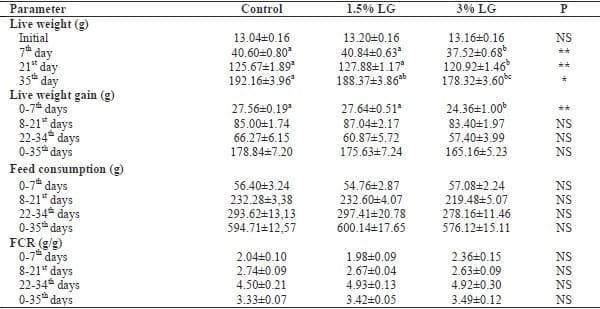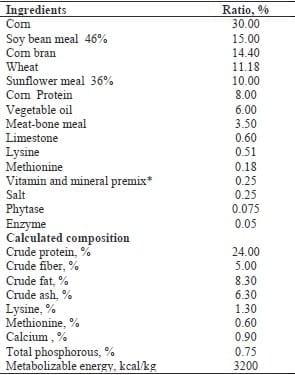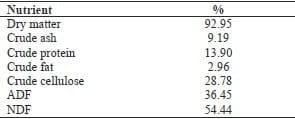Introduction
Due to increases in population, income and living standards, consumers’ demand shifts to higher quality, various, and more poultry meat consumption. The poultry industry is presently studying on alternatives to meet these consumers’ demands. Also, scientists are trying much more efforts to respond to these expectations. On the other hand, they want to make sure this does not decrease the quality of the end product or ignore animal welfare. Nowadays, increasing of consumer awareness for safety poultry products and from stable to table approach tended the consumers’ preferences towards to healthy animals’ products. Performance enhancers until recently called growth promoters are used to improve animal growth rate and/or feed conversion ratio. One of the feed additives used to increase the performance of poultry are herbs. Herbs are the dried leaves of aromatic plants, usually found without stems (Peter, 2012). In particular, with the ban on the use of antibiotics to increase growth, studies on plant-based alternatives have increased.
Lemon grass (Cymbopogon citratus, LG) contains flavonoids, phenolic compounds, terpenoids (Burkill, 1996) and essential oils (such as citral α, citral β, nerol geraniol, citronellal, terpinolene, geranyl acetate, myrecene and terpinol methylheptenone) which may be responsible for its different biological activities such as antibacterial, antidiarrheal, antifungal, antioxidants, and as a growth promoter (Shah et al., 2011). There are few scientific studies on the use of LG or its secondary metabolites for performanceenhancing purposes in poultry, especially in broilers (Mmereole, 2010; Mukhtar et al, 2012; Thayalini et al., 2011), pigs (Tartrakoon et al., 2002) and rabbits (Omer et al., 2010). Mmereole (2010) and Mukhtar et al. (2012) reported that lemon grass could be an alternative to antibiotics. In contrast to others, Thayalini et al. (2011) reported that lemon grass did not improve the performance, but even decreased.
According to the authors’ knowledge, no study has been conducted on lemon grass supplementation to quails’ diet. Therefore, the aim of the present study was to investigate the effect of LG on performance, carcass quality traits, and marketing of quails.
Materials and methods
Animals and Diets
A total of 150 unsexed four-day-old Japanese quail (Coturnix coturnix japonica) were distributed three groups of 50 quails each, following four day adaptation period. The quails were housed in wire cages with dimensions of 50×90×20 cm (width, length, height). They were allowed free access to food and water. The heater temperature was set at 33ºC at the beginning of the study and decreased by 3 degrees every week for 3 weeks and they were kept at 24oC for the rest of the study. The lighting schedule was 24 hours during the experiment. The quail were fed for 5 weeks with iso-caloric and isonitrogenic diet containing 0% (control group), 1.5% and 3% lemon grass leaf meal (treatment groups).
The lemon grass (Cymbopogon citratus) was collected from the Antalya province of Turkey (located in Mediterranean region), dried in the shade and kept in dry conditions for 2 weeks and then ground into fine particles before being added to the diets.
The composition of basal diet and lemon grass leaf meal used in this study is given in Table 1 and 2.
Meat Properties
pH
In breast meat samples (20 birds per group) the pH values were measured by using a pH meter (Thermo Scientific Orion Star A111) at 1 h (pH1) and 24 h (pH24) after slaughter. To determine pH, the probe was inserted into the center of the breast muscle (pectoralis major), 0.5 to 1 cm below the surface of the muscle and then the pH value was read.
Cooking loss
Cooking loss was determined in 1.5 cm-thick breast meat samples of similar geometry, individually placed inside polyethylene bags in a water bath at 75°C for 30 min until the temperature of 70 °C was achieved and then cooled for 30 min. The samples were removed from the bags, dried with paper and weighed (Önenc and Kaya, 2004). The weight loss, expressed as a percentage of initial weight, was determined as the cooking loss.
Thawing loss
Meat samples of about 10 g were frozen at - 20 ºC overnight and thawed. The free water was discarded and then the samples were reweighed and the difference between the first and last weight was calculated as thawing loss percentage (Honikel, 1998).
Analytic procedures
The dry matter, crude protein, fat, cellulose and ash content of lemon grass and meat samples were determined according to AOAC (2001). The lemon grass crude fiber (CF), acid-detergent fiber (ADF) and neutraldetergent fiber (NDF) levels were determined with ANKOM Technology Method 2008 (Ankom15, ANKOM Technology, New York, USA). The feed’s metabolizable energy contents were calculated by using the TSE (1991) equation.
Statistical and economic analysis
The current data were analyzed using the General Linear Models (GLM) procedure of the SPSS (version 15.0). The models included control, 1.5%, and 3% lemon grass level. Means were separated using Duncan’s multiple range test and a 5% level of probability was used. To calculate the effect of sex ratio, the X2 (chisquare) test was performed. The results of statistical analysis were shown as mean values and standard error of the means (SEM) in the tables. In economic evaluation; the total income, total cost and net income increase/decrease were calculated as follows;
Total income = [total carcass weight (g) × carcass price (TL)]
Total cost = [feed consumption (kg) × feed cost (TL)] + [the amount of lemon grass added in feed (g) × lemon grass cost (TL)]
Net income increase/decrease = total income – total cost
In the study, accepted quail feed cost was 1.00 TL/kg, carcass price was 15 TL/kg, and lemon grass cost was 50 TL/kg.
Results
Live weight, live weight gain, feed consumption and feed conversion ratio were not affected in 1.5% LG supplemented group (P>0.05); however, in 3% LG supplemented group decreased body weight at the 7th, 21st and 35th days (P<0.05) compared to the control group (Table 3).
Table 3. The effect of supplementation of lemon grass on performance traits.
 a,b,c
a,b,c: Values with different superscript in a line differ significantly P:probability, *:p<0.05, **:p<0.01,. LG: lemon grass, NS: non-significant, FCR: feed conversion ratio.
Additionally, first 7 days results in the 3% LG supplemented group live weight gain was significantly lower than those of other groups, but after the 7th day, live weight gain was not affected by LG supplementation. Both levels of LG used in this study had no effect on feed consumption and feed conversion ratio. In the 3% LG supplemented groups’ intestinal weight and proportion were decreased (P<0.05). However, LG did not affect slaughter and carcass weight, dressing percentage, intestine, liver and gizzard weight and their ratios (p>0.05; Table 4).
Table 4. The effect of supplementation of lemon grass on carcass traits.
 a,b
a,b: Values with different superscript in a line differ significantly **:p<0.01,. LG: lemon grass, NS: non-significant.
Also, some carcass quality characteristics such as pH, cooking loss, thawing loss, dry matter, ash, and protein content were not affected by LG supplementation (p>0.05; Table 5).
Table 5. The effect of supplementation of lemon grass on meat quality.

P: probability, LG: lemon grass, NS: non-significant.
In the economic assessment, LG supplementation did not provide any advantage either in feed consumption and live weight gain or in carcass values and quality, it even decreased the revenue (Table 6). The distribution of quails’ sex (female, male) in each group were not significant (p>0.05).
Table 6. The effect of supplementation of lemon grass on revenue*.

*Data were given for groups (50 quail). LG: lemon grass.
Discussions
The quail diet supplemented with 3% LG leaf meal showed a significantly lower final body weight compared to the control (p<0.05). This finding was similar with Thayalini et al. (2011) who reported that reduced body weight in broilers fed with 2% LG leaf supplemented diet. However, this result was contrary to those of Mmereole (2010) and Mukhtar et al. (2012) who reported that supplementation of LG leaf meal or oil resulted in a significantly higher body weight in broilers. During the first week of the study, there was a significant difference in the 3% LG group in body weight gain. However, body weight gain was not significant among groups during the last four weeks and overall. These findings were different from some previous studies (Mukhtar et al., 2012; Mmereloe, 2010; Thayalini et al., 2011).
The expected effects of herbs on feed consumption could be related with improvement in feed taste, palatability, enhanced appetite of poultry in addition to faster passage and digestion of nutrients through the digestive effects of herbs (Mmereloe 2010; Mukhtar et al., 2012).
Mukhtar et al. (2012) reported that 50, 100 and 150 mg/kg supplementation of LG oil in broiler diets caused an increase in the feed consumption. Similar to present results, Mmereloe (2010) reported that the supplementation of 1% LG leaf to broiler diets did not affected feed consumption. There was no statistical difference among the groups in terms of feed consumption in weeks and overall period. Differences between the results in the literature on feed consumption could be related with the form of LG used (leaf or oil).
Mukhtar et al. (2012) reported that supplementation of 0.5%, 1% and 1.5% LG oil and Thayalini et al. (2011) supplementation of 2% LG leaf to diet did not affect the feed conversion ratio in broilers. Similarly, supplementation of 1.5% and 3% LG leaf did not affect the feed conversion ratio of quail; whereas Mmereole (2010) reported that 1% LG leaf supplementation to broiler diet improved the feed conversion ratio.
Results revealed that there were no significant differences (P>0.05) among groups regarding carcass yield, liver and gizzard ratio, and meat chemical composition such as crude protein, ash and dry matter. These results are consistent with the findings of Mukhtar et al. (2012), they did not find significant effect of LG addition to diet on carcass and meat traits in broilers.
In contrast to Mukhtar et al. (2012), economic evaluation of this study showed that the supplementation of LG leaf meal to quail diet did not improve performance and revenue compared to the control group. This was probably due to the cost of LG leaf meal and the supplemented level.
The controversial results between studies could be related with plant origin, harvest time, processing, extraction method, storage conditions and period, dietary inclusion levels and form of herbs.
In conclusion, it is necessary to determine the optimum dietary inclusion levels and used form/type (leaf, oil, dried and fresh) of LG and their effect on revenue in future studies.
This article was originally published in Scientific Works. Series C. Veterinary Medicine. Vol. LXII (1).
References
AOAC., 2001. Official Methods of Analysis of the Association of Official Analytical Chemists. 17th ed., Inc., Arlington, Virginia.
Burkill H. M., 1996. The useful plants of West Tropical Africa. Vol 3, Families J-L, Royal Botanic Gardens, Kew Publishing, 2nd ed.: pp.29-30. United Kingdom.
Honikel K.O., 1998. Reference methods for the assessment of physical characteristics of meat. Meat Science, 4: 447-457.
Mmereole F.U.C., 2010. Effects of lemmon grass (Cymbopogon citratus) leaf meal feed supplement on growth performance of broiler chicks. Inter. Journal of Poultry Science, 9(12): 1107-1111.
Mukhtar A.M., Mohamed K.A., Amal, O.A, Ahlam, A.H., 2012. Effect of different levels of lemon grass oil (LGO) as a natural growth promoter on the performance, carcass yields and serum chemistry of broiler chicks. Egyptian Poultry Science, 33: 1-7.
Önenç A., Kaya A., 2004. The effects of electrical stunning and percussive captive bolt stunning on meat quality of cattle processed by Turkish slaughter procedures. Meat Science 66, 809-815.
Peter KV. Handbook of herbs and spices. . Introduction to herbs and species: medicinal uses and sustainable production Woodhead Publishing Series in Food Science, Technology and Nutrition, Number 228; p: 1-15; 2012.
Shah G., Shri R., Panchal V., Sharma N., Singh B., Mann A. S., 2011. Scientific basis for the therapeutic use of Cymbopogon citrates, stapf (Lemon grass). Journal of Advanced Pharmaceutical Technology & Research, 2(1): 3-8.
Tartrakoon W., Wuthijaree K., Vearasilp T., Meulen U., 2002. Use of Lemon Grass Oil as Feed Additive in Weanling Pig Diets. Conference on International Agricultural Research for Development. Deutscher Tropentag, Witzenhausen, October 9-11, 2002. Omer H.A.A., Elallawy H.M.H., AbdEl-Samee L.D., Maghraby, N., 2010. Productive performance of rabbits fed diets containing lemongrass or active dry yeast. American-Eurasian Journal of Agriculture & Environmental Science, 7(2): 179-187.
Thayalini K., Shanmugavelu S., Saminathan P.M., Siti Masidayu M.S., Nor Idayusni Y., Zainuddin H., Nurul Akmal C.A., Wong H.K., 2011. Effects of Cymbopogon citratus leaf and Zingiber officinale rhizome supplementation on growth performance, ileal morphology and lactic acid concentration in broilers. Malaysian Journal of Animal Science, 14:43-49.
TSE., 1991. Turkish Standards Institution, Animal Feeds-Determintion of Metabolizable Energy (Chemical Method). TS No: 9610, Ankara.Web: https://intweb.tse.org.tr/standard/standard/Standard.a spx


 a,b,c: Values with different superscript in a line differ significantly P:probability, *:p<0.05, **:p<0.01,. LG: lemon grass, NS: non-significant, FCR: feed conversion ratio.
a,b,c: Values with different superscript in a line differ significantly P:probability, *:p<0.05, **:p<0.01,. LG: lemon grass, NS: non-significant, FCR: feed conversion ratio. a,b: Values with different superscript in a line differ significantly **:p<0.01,. LG: lemon grass, NS: non-significant.
a,b: Values with different superscript in a line differ significantly **:p<0.01,. LG: lemon grass, NS: non-significant. P: probability, LG: lemon grass, NS: non-significant.
P: probability, LG: lemon grass, NS: non-significant. *Data were given for groups (50 quail). LG: lemon grass.
*Data were given for groups (50 quail). LG: lemon grass.









.jpg&w=3840&q=75)